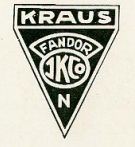Kraus-Fandor
The company Jos. Kraus et al. Co. is known colloquially as Kraus-Fandor and was a toy manufacturer that was founded in 1910 by Josef Kraus and Milton and Julius Forchheimer in Nuremberg as a general partnership. The registration at the Nuremberg trade office took place on January 24th, 1910. The start of operation was on January 1st, 1910. 2 people were employed and the production took place in the "engine operation with about 20 machines". The company headquarters was at Austraße 108 in Nuremberg, Gostenhof. The company's name is an acronym made up of the first names of the founder's mother and aunt, Dora and Fanny. The company was a typical representative of the "Nuremberg manufacturers" of so-called sheet metal railways. Kraus-Fandor manufactured clockwork-operated and electric model railways from sheet metal in 0 and 1 gauge. The distribution took place largely through department store ranges. The company brand was KRAUS FANDOR JKCo N Germany , KRAUS or FANDOR . The term FANDOR was mostly only used for export. The company was stopped again in 1938 after Jos. Kraus had left Germany in 1933, presumably for political reasons. Kraus-Fandor was placed under compulsory administration by law in 1943. In 1963 it was deleted from the Nuremberg Commercial Register.
Fandor / Dorfan
The toy trains produced were partly based on the American model, which is why there was high demand in the USA. However, protective tariffs made it difficult for the company to compete with American toy manufacturers after the First World War , which is why the brothers Julius and Milton Forchheimer emigrated to America together with an engineer, where they founded the Dorfan company in Newark (New Jersey) (only staggered letters from Fandor) founded. With this company they specialized in railways of gauge 0 as well as standard gauge . The die-casting process , which is susceptible to zinc plague, was used for production. This company had to stop production as early as 1934, although sales were maintained until 1936.
Patents
Between 1910 and 1934 numerous patent specifications were filed with the Imperial Patent Office, later Reichspatentamt (today: German Patent and Trademark Office ). On February 1, 1910, the “rail joint connection for toy trains with spring locking for the pin going into the head of one end of the rail” (original description from the patent) was patented. In the same year a special patent was granted for the connection between rail and sleeper in toy trains. Another notable patent is the invention of an automatic mechanical coupling between toy trains.
Overhead lines
The company was one of the few toy manufacturers at that time to manufacture so-called overhead contact lines . With the clockwork tracks and a contact wire, the modern and real technology of this time could be represented in the game. The central conductor line for the electrical tracks, which was common at the time, was saved. The track structure thus corresponded to reality. Power was supplied via the clockwork track and the flexible pantograph on the locomotive. Thanks to the flexible pantograph, inequalities in the tracks could be easily compensated. Using a standard three-rail track , it was now possible to control two trains on one layout independently of each other.
Streamlined locomotives 05001

The company adapted to the trend and technical progress of the time and produced a streamlined steam locomotive from the mid-1930s . This in a very simplified version in the tin printing process . The numbers "05001" were printed on the front of the locomotive, based on the Reichsbahn prototype. The same model was available from the company in a silver color
and a somewhat smaller streamlined steam locomotive in red. The locomotives were offered in clockwork operation as well as for AC operation.
Exhibition - Museum Petersberg
The Museum Petersberg near Halle shows since 2016 in a permanent exhibition of exhibits and the detailed history of tin toys factory Jos. Kraus & Co.
literature
- Gustav Reder : With clockwork, steam and electricity. From toys to model trains . Alba-Buchverlag, Düsseldorf 1970
- Rudger Huber: tin toys. Cars - Motorcycles , Weltbild 1995. ISBN 3-8289-0794-6
Web links
- Database for old toys (Kraus-Fandor) products
- Forum old model railways
- The fascination of sheet metal railways. Products from Josef Kraus & Co., Nuremberg. (jena.de)
- Mitteldeutsche Zeitung: Museum Petersberg "Model locomotives will soon be doing their rounds"
- Hall spectrum: tin toys in the Petersberg Museum
- Website Museum Petersberg: Exhibition of railway and tin toy factory Josef Kraus & Co, Nuremberg











